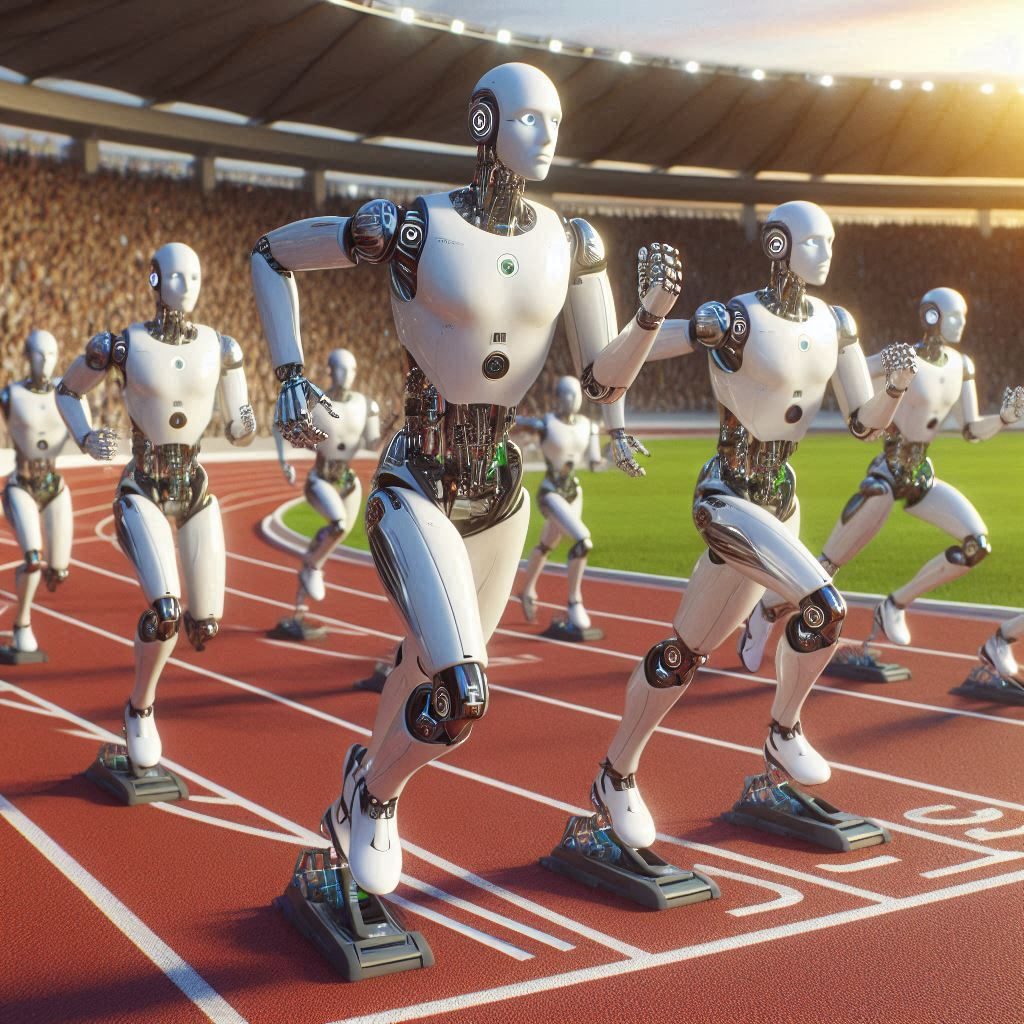Like most Americans, I get pumped for the Olympics.
Next year, I’m hoping my young daughters will have enough of an attention span to watch the Winter Games with me and my wife.
And I’m really looking forward to the 2028 Summer Games returning to the U.S. for the first time in three decades.
Earlier this month, Beijing hosted an Olympics-like event that was the first of its kind.
Competitions at this event ranged from soccer to medicine-sorting. They also included track and field events like the long jump and running.
But instead of humans lining up to start the races, there were humanoid robots.
That’s because this event was China’s first-ever World Humanoid Robot Games. And it was a sight to behold.
During the preliminary round of the 100-meter dash, the starting gun fired…
And within seconds, several robots stumbled around as if they’d had too much to drink.
if you’ve seen any of the footage, it looked more like slapstick comedy than cutting-edge technology.
But Beijing isn’t joking around. It’s dead serious about investing billions to make robots as central to its economy as semiconductors and EVs.
And each medal ceremony at the World Humanoid Robot Games was a reminder of the scale of China’s ambitions…
The Race to a Robot Future
This year alone, Beijing has poured $20 billion in subsidies into robotics.
It’s also planning a 1 trillion yuan fund — about $137 billion — to accelerate production and research in this field.
China doesn’t want to repeat the mistakes that led to its dependence on foreign semiconductors.
So it has made robotics a national priority on par with chips and electric vehicles.
And even though their robots might not be graceful yet, China is betting big that they’ll be indispensable.
Meanwhile, here in the U.S., robots aren’t running races… yet.
But they are clocking in.
Walk through the halls of St. Anthony’s Hospital in Florida, and you’ll see two robots named Beaker and Hygeia gliding past patients.
Source: baycare.org
The work they do is mundane, but it’s vitally important. They move lab samples and pharmacy items throughout the hospital.
Since January, Beaker and Hygeia have eliminated more than 1,100 miles of walking for nurses. That’s thousands of staff hours redirected from pushing carts to direct patient care.
And at hospitals across the country, Diligent Robotics’ Moxi robot is helping in similar ways.
Source: Diligent Robotics
Over the past two years, Moxi has completed more than one million deliveries and saved staff 600,000 hours of walking.
In other words, these machines free up skilled workers to do the work that only humans can do.
And healthcare isn’t the only industry benefiting from robotics here in the U.S.
In fast food kitchens, Miso Robotics’ Flippy is whipping up batches of French fries at Jack in the Box and White Castle.
Source: Miso Robotics
Meanwhile, Chipotle is rolling out its Autocado robot to peel and slice avocados.
Source: Chipotle
That might seem like a simple task, but it’s one of the most time-consuming jobs on the prep line.
And, like Flippy, the Autocado reduces labor costs while keeping food flowing during peak hours.
Outside the kitchen, Serve Robotics is revolutionizing last-mile delivery.
In Los Angeles, its autonomous sidewalk bots are already bringing Little Caesars pizzas straight to customers.
Source: Serve Robotics
The company expects more than 2,000 units on U.S. streets by year-end, with expansions underway in Atlanta, Dallas and Miami.
And on the highways of West Texas, Kodiak Robotics’ driverless semis are hauling sand for Atlas Energy Solutions at this very moment.
As of mid‑2025, four of these trucks have already logged more than 800 loads and 1,600 autonomous hours driving across the Permian Basin.
They operate 24/7 with no driver in the cab, only pausing now and then for maintenance or fuel.
Atlas plans to expand to 100 trucks in the coming years.
This is what robotics looks like in the real world today. Even if you rarely notice them, they are quietly reshaping the economy.
And humanoid robots, like the ones at the World Humanoid Robot Games, could soon be the fastest-growing segment of robotics.
Last year, Goldman Sachs predicted that human-like robots could be worth a whopping $38 billion by 2035.
While Morgan Stanley Research estimates the number of humanoid robots is likely to reach nearly 1 billion by 2050.
Including the related supply chain, as well as maintenance and repair networks, this could add up to a $5 trillion market in the next quarter century.
That’s twice the size of the auto industry.
Yet it could be a conservative estimate. After all, Elon Musk is on record that there will be at least 10 billion humanoid robots in existence by 2040, each priced between $20,000 and $25,000.
But how can U.S. robotics companies today compete against Beijing’s massive subsidies?
After all, the federal government isn’t likely to write a $100 billion check to help build a fleet of robots. Especially since improving the country’s infrastructure is far more important to the future of the U.S.
That’s where American ingenuity comes in.
Nvidia has become the toolmaker for the robotics world.
Its chips and software power everything from warehouse bots to hospital couriers.
Today, more than two million developers use Nvidia’s robotics platform to design, test and train robots before they ever hit the factory floor.
And the company just released Jetson Thor, a new kind of chip built specifically for humanoid robots. It gives robots the ability to process vision, movement and decision-making in real time.
For U.S. startups that aren’t getting a penny in subsidies, Jetson Thor is like handing them the keys to a supercomputer that fits in the palm of a hand.
There’s also the open-source ROS2 framework.
This software lets robots from different companies share intelligence and coordinate tasks.
Imagine a warehouse where if one robot goes down, others automatically reroute to cover its workload. That’s the flexibility and resiliency that ROS2 offers, and it’s and it’s free for anyone to use.
Yet, neither of these examples will grab headlines like a robot collapsing on a track in Beijing.
Here’s My Take
The footage coming out of Beijing might look like comedy. After all, many humanoid robots are still clumsy.
But I remember when cellphones were the size of bricks, when PCs were bulky and unreliable and when dial-up was considered cutting-edge.
Technology is moving at light speed these days.
And within the next decade, humanoid robots could be stocking shelves, cooking meals and driving trucks so seamlessly that they won’t be news anymore.
That’s why I wrote up a special urgent report for members of Strategic Fortunes with my #1 backdoor investment into this upcoming megatrend.
If you’re not a member, click here now to find out more.
We also have some incredible robotics plays in our Extreme Fortunes model portfolio.
Because I’m extremely bullish on this sector.
And I am especially looking forward to the robot that can fold laundry and empty the dishwasher.
Before we know it, robots will just be part of the economy, as natural as smartphones are today.
And that seamless adoptions will be a good thing…
Because we don’t want China to have the last laugh in the robot race.
Regards,
Ian King
Chief Strategist, Banyan Hill Publishing
Editor’s Note: We’d love to hear from you!
If you want to share your thoughts or suggestions about the Daily Disruptor, or if there are any specific topics you’d like us to cover, just send an email to [email protected].
Don’t worry, we won’t reveal your full name in the event we publish a response. So feel free to comment away!
Disclaimer: This story is auto-aggregated by a computer program and has not been created or edited by finopulse.
Publisher: Source link








